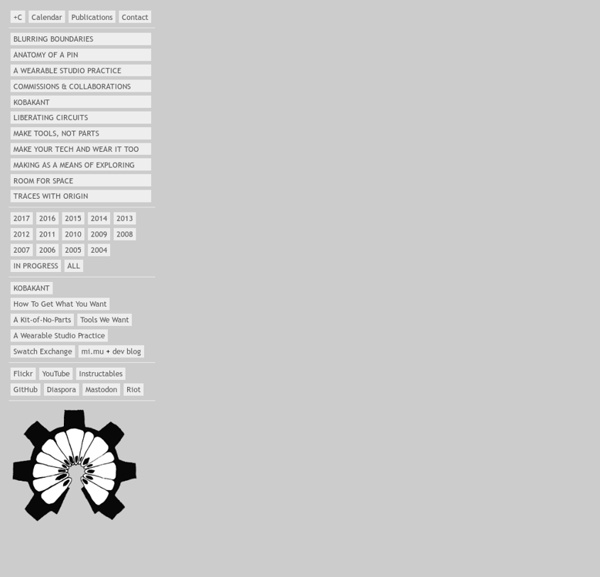



KOBAKANT Bonifaz Kaufmann HOW TO GET WHAT YOU WANT Welcome to the KOBAKANT DIY Wearable Technology Documentation Workshops least likely scenario This workshop is part of a course at the Ernst Busch Hochschule in Berlin. Workshops soft sensors for soft bodies FURTHER_READING_WATCHING_LISTENING_ Elektronische Textilien als Material und Werkzeug_ Hannah Perner-Wilson, Irene Posch, 2020 “Welche Fasern leiten Strom? Workshops connecting bubbles This semester, we are sitting in a strange bubble at home. Sensors 6 really wearable sensors The textile sensors on our website are often not designed to be manipulated with your hands. Workshops soft interactive technologies This workshop is a part of a course at the Art Academy Weissensee Berlin. Workshops ETextile Adventures This workshop is part of a course at the Ernst Busch Hochschule in Berlin. Sensors Sole Sensing Rather simple way of making insoles with 3 pressure sensors located at different pressure points of the foot on the ground. Actuators Vibe Modules Workshops from SPACE to SPACE with NO SCREENS? Power
3lectromode Jie Qi - DREU Participant 2009 school: Columbia University major: mechanical engineering year: graduated May 2010 contact: jieqi[at]media.mit.edu website: technolojie.com My name is Jie Qi and I'm interested in all things art and technology, especially where the two blend. Through DREU (Distributed Research Experiences for Undergraduates), I spent the summer researching with Leah Buechley as part of the High-Low Tech group in the MIT Media Lab. More recent work can be found on my Flickr page and Youtube page. Kit-of-No-Parts I wish I had made one of these. But no, not yet. Inspired by the work of Arthur Ganson and other kinetic artists, this post features some mechanical gears assembled and sculpted from various materials such as wire and cardboard. In contrast to casting traces by applying the cast material selectively to a flat surface, molded circuitry is cast into a mold. I’m interested in being able to cast both flexible and firm conductive materials in combination with common casting materials such as silicone and epoxy. This post describes various attempts at creating molds and […] Battery pouches made from paper, plastic and fabric are quick to make and are a cheap alternative to commercially available options. This coin-cell holder is made using copper tape and a mini cloths peg. This is one of the quickest techniques for prototyping circuits, as well as an efficient and reliable way of making flat and flexible circuitry. Fountain pens can be used to draw with conductive paint. Second attempt:
VALERIE LAMONTAGNE emily marie lovell {research} education currently at Massachusetts Institute of Technology research assistant in the high-low tech group at the media lab ph.d. student in media arts and sciences previously studied at Center for Digital Imaging Arts at Boston University certificate in graphic design graduated from University of California at Santa Cruz (College Nine) b.a. in computer science, concentration in computer graphics minor in electronic music studied abroad with Semester at Sea voyage photos and musings publications LilyPond: An Online Community for Sharing E-Textile Projects Emily Lovell and Leah Buechley In Proceedings of Creativity & Cognition (2011) Living Wall: Programmable Wallpaper for Interactive Spaces Leah Buechley, David Mellis, Hannah Perner-Wilson, Emily Lovell, and Bonifaz Kauffman In Proceedings of Multimedia (2010) CopyCAD: Remixing Physical Objects with Copy and Paste from the Real World Sean Follmer, David Carr, Emily Lovell, and Hiroshi Ishii An E-Sewing Tutorial for DIY Learning projects LilyPond